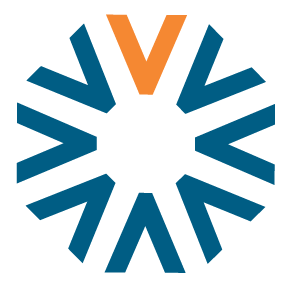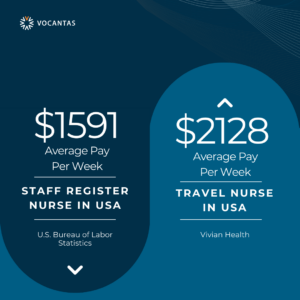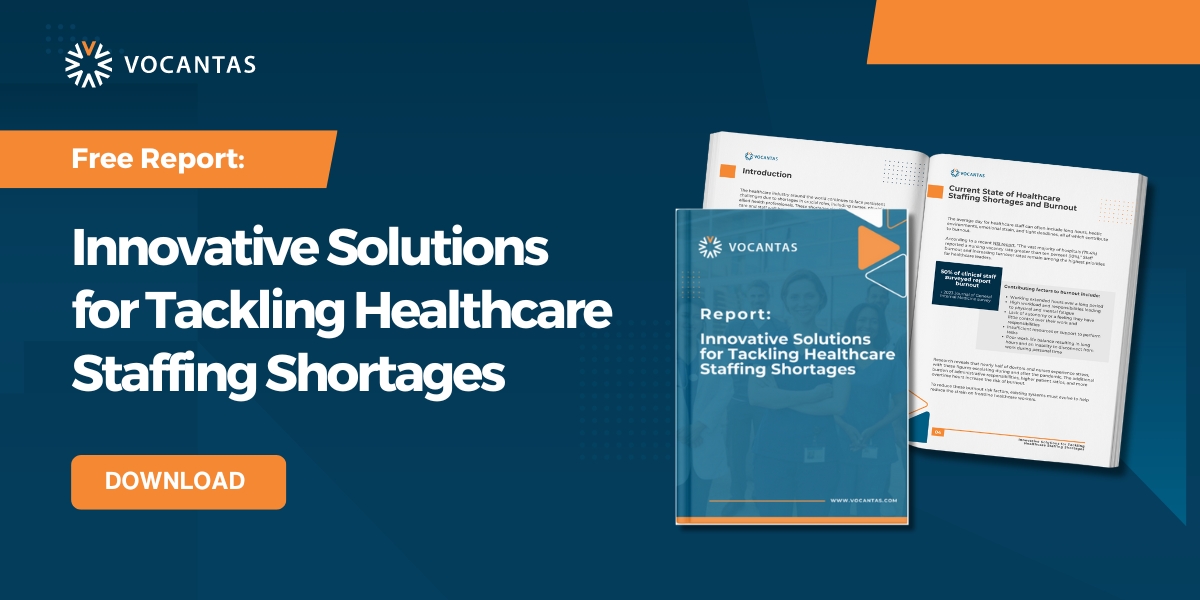Blog
Boosting Nurse Retention: Innovative Strategies for Healthcare Leaders
Tuesday March 26, 2024
The global healthcare industry is projected to face a shortage of 18 million healthcare professionals by 2030, underscoring the critical importance of retaining nursing talent. As the backbone of patient care, the trend of nurses abandoning direct patient care roles poses a significant threat to the future of healthcare services worldwide. Complicating this challenge is the economic impact of nurse turnover: the average cost of turnover for a staff RN has escalated to $52,350, with the range averaging $40,200 to $64,500. This marks a considerable increase from the average cost of turnover for an RN in 2021, which was $46,100. Recent figures further reveal that 31% of nurses are contemplating leaving their positions, with 75% of hospitals grappling with nursing vacancy rates exceeding 10%, according to the latest National Health Care Retention Report.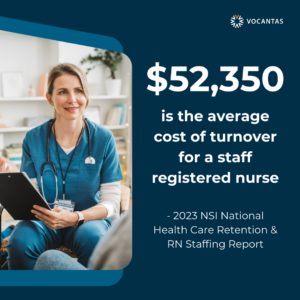
These figures are not mere statistics; they are a clarion call for immediate and decisive action to retain nursing talent. The situation is exacerbated by the alarming increase of nurses (42%) who cite an unsafe working environment as a significant reason for leaving direct patient care roles, a sharp rise from 24% in March 2022.
This blog aims to provide deep insight into the causes of low nurse retention and offer strategies that healthcare organizations can adopt to retain more nurses and staff. By addressing these challenges, healthcare facilities can ensure efficient operation and positive patient care outcomes, mitigating the financial and operational impacts of high turnover rates.
Contributing Factors to Low Nurse Retention Rates
Severe Burnout and Emotional Fatigue
The emotional weight of caring for patients, especially in high-stress areas like emergency rooms or intensive care units, can lead to compassion fatigue. Nurses often carry the emotional burden of their patients’ experiences, which, when coupled with physical exhaustion from long shifts, leads to severe burnout.
Compensation Disparity
The discrepancy between the high level of responsibility and risk involved in nursing and the compensation received is a significant factor in nurse turnover. In fact, the U.S. Bureau of Labor Statistics reports the average weekly pay of a registered nurse on staff is $1519, which is significantly less than the average weekly pay for a Traveling Nurse of $2128, according to Vivian Health. This disparity becomes even more pronounced when considering the additional stress and health risks, particularly in pandemic situations or in specialties that involve high-risk patient care.
Stagnation and Lack of Professional Development
The healthcare field is dynamic, with constant advancements in treatment methods and technology. Nurses who find themselves in environments that do not support ongoing learning or career advancement may feel professionally stagnant, prompting them to seek opportunities elsewhere where they can grow and learn.
Erratic Schedules and Lack of Downtime
Nursing schedules often involve night shifts, weekends, and holidays, leading to a disruption of personal life and social activities. The inability to participate in family events or maintain a consistent social life due to erratic work hours contributes to a poor work-life balance.
Looking to learn more? Check out our blog: Tech Solutions For Managing Healthcare Staffing Shortages
Understaffing
Persistent understaffing leads to a cycle of overwork for the existing staff, increasing the risk of medical errors, reducing the quality of patient care, and causing physical and emotional strain on nurses.
Deteriorating Work Environment and Interpersonal Relationships
A work environment that lacks mutual respect, support, and effective communication can erode job satisfaction. Interpersonal conflicts, whether with colleagues or management, contribute to a toxic atmosphere, making it challenging for nurses to thrive.
Strategies for Nurse Retention
Fair Compensation Models
Implementing fair and transparent compensation models that clearly outline how pay is determined is important. This can include differential pay for specialized skills, certifications, and shifts like nights, weekends, and holidays. This ensures that employees are fairly compensated for their work and that they have a clear understanding of how their pay is determined. Overall, this can help build employee trust and loyalty, leading to a more productive and successful organization.
Embracing Technology to Optimize Staff Utilization
One of the key strategies for improving nurse retention is the adoption of technology that can optimize staff utilization. Vocantas, a leader in this domain, offers solutions that enhance communication and scheduling, thereby reducing burnout and improving job satisfaction among nurses. By implementing advanced scheduling systems, healthcare facilities can ensure that shifts are distributed evenly, preferences are considered, and nurses are not overburdened. Such systems can also facilitate swift shift swaps and fill vacancies more efficiently, ensuring that the workload is manageable and nurses feel supported.
Offering Nurse Schedule Flexibility
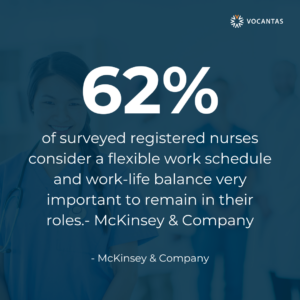
Professional Development and Education Plans For Nurses
Work with each nurse to develop a personalized professional growth plan that aligns with their career goals, interests, and the needs of the hospital, including leadership tracks, specialized clinical training, and research opportunities. Consider offering substantial support for advanced education, including flexible schedules for attending classes, full or partial tuition reimbursement, and opportunities for clinical application of new skills within the hospital setting.
Utilizing Data to Forecast Healthcare Staffing Requirements
Understaffing is a common issue in healthcare settings, leading to increased stress levels among nurses and, ultimately, higher turnover rates. To combat this, healthcare organizations can use data analytics to forecast staffing needs accurately. By analyzing trends in patient admissions, seasonality, and historical staffing patterns, organizations can predict periods of high demand and adjust staffing levels accordingly. This proactive approach ensures that the facility is adequately staffed, reducing the burden on nurses and improving patient care. Vocantas’s solutions, for example, can integrate with existing workforce management systems to provide valuable insights into staffing needs, helping managers make informed decisions.
Professional Development and Education Plans
Work with each nurse to develop a personalized professional growth plan that aligns with their career goals, interests, and the needs of the hospital, including leadership tracks, specialized clinical training, and research opportunities. Consider offering substantial support for advanced education, including flexible schedules for attending classes, full or partial tuition reimbursement, and opportunities for clinical application of new skills within the hospital setting.
Diversity, Equity, and Inclusion Initiatives
Actively promote diversity, equity, and inclusion within the nursing staff and management through targeted recruitment, bias training, and creating spaces for voices from diverse backgrounds to be heard and valued.
Conclusion
Retaining skilled nurses is crucial for delivering high-quality patient care and ensuring the smooth operation of healthcare facilities. By adopting technology to optimize staff utilization, offering greater schedule flexibility, and using data to forecast staffing requirements, organizations can create a more supportive and attractive work environment for nurses. Technology solutions like those provided by Vocantas are already being used by hundreds of hospitals to address the challenges of nurse retention and staff utilization. As the healthcare industry evolves, we must continue to develop and implement strategies that support the well-being and professional satisfaction of nursing staff.
Stay Connected!
Subscribe to our newsletter and receive all our news and updates.
Blog
Check out our
latest Blog Posts
Cutting-edge technologies, industry trends and best
practices workforce management.

Wednesday January 29, 2025
Optimizing Workforce Efficiency with Integrated Manufacturing Scheduling Software
The manufacturing industry operates on precision and efficiency. From raw material sourcing to final product assembly, every second counts. Yet,….

Wednesday January 15, 2025
Top 5 Nursing Home Software Solutions to Invest in for Efficient Operations
As staffing shortages and external factors continue to impact the healthcare industry, nursing homes face increasing pressure to provide high-quality….

Thursday December 19, 2024
Absence Management Guide: Tools to Maximize Workplace Efficiency
Managing employee absences effectively is a cornerstone of organizational success. A well-implemented absence management system not only ensures accurate payroll….

